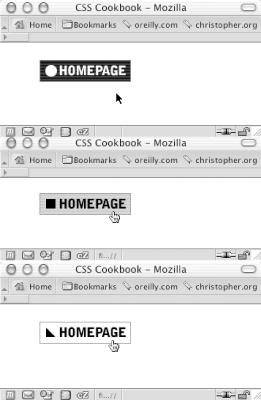3.10. Creating Image-Based Rollovers
Problem
You want image-based rollovers to replace text links.
Solution
First, wrap the text inside the anchor element in a
span:
<a href="/" id="linkhome"><span>Homepage</span></a>
Next, instead of JavaScript, use the
background-image property within the pseudo-class
selectors :hover and :active to
swap the images (see Figure 3-17):
a span {
display: none;
}
a:link {
display: block;
width: 125px;
height: 30px;
background-image: url(btn.gif);
background-repeat: no-repeat;
background-position: top left;
}
a:link:hover {
display: block;
width: 125px;
height: 30px;
background-image: url(btn_roll.gif);
background-repeat: no-repeat;
background-position: top left;
}
a:link:active {
display: block;
width: 125px;
height: 30px;
background-image: url(btn_on.gif);
background-repeat: no-repeat;
background-position: top left;
}
Figure 3-17. The link with default, rollover, and active states
Discussion
Replacing text with an image has five benefits. First, it separates the text from the presentation. The image that contains more elaborately formatted type is part of the presentation and therefore controlled by a style, while the content in the markup remains pure text. The second benefit is that an image heading can be modified across a whole site by one change of the style sheet. The third benefit is that this method works for alternative styles and style sheet switching. ...
Get CSS Cookbook now with the O’Reilly learning platform.
O’Reilly members experience books, live events, courses curated by job role, and more from O’Reilly and nearly 200 top publishers.

